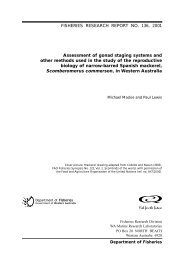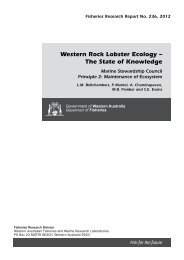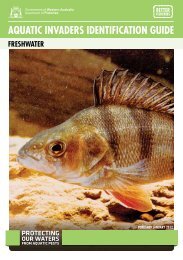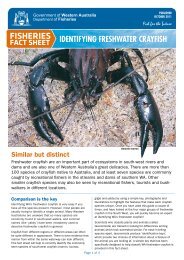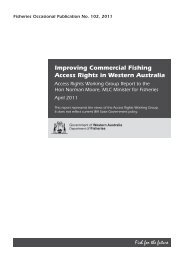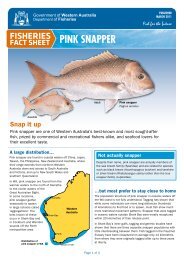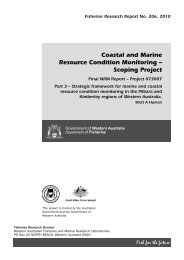West Australian Dhufish Fact Sheet - Department of Fisheries
West Australian Dhufish Fact Sheet - Department of Fisheries
West Australian Dhufish Fact Sheet - Department of Fisheries
Create successful ePaper yourself
Turn your PDF publications into a flip-book with our unique Google optimized e-Paper software.
The importance <strong>of</strong> big dhuies<br />
<strong>Dhufish</strong> can live for more than 40 years, reach more than a<br />
metre in length and weigh more than 25 kilos. As with many<br />
bottom-dwelling fish, they are relatively slow-growing.<br />
They also grow most quickly when they are young. Their growth<br />
slows down considerably after about 12 years, and they<br />
reach close to their maximum size at about 20 years. Like all<br />
animals, individual dhufish may be larger or smaller than their<br />
peers at the same age.<br />
Previous research showed that dhufish start to reach sexual<br />
maturity at three to four years old, or when they were 30 to 35<br />
centimetres long. Recent research indicates that even though<br />
dhufish are reproductive at this time, females produce few<br />
eggs and do not spawn every month <strong>of</strong> the spawning season.<br />
It appears that dhufish only reach their full reproductive<br />
potential as they become larger and thus older.<br />
Older and larger female dhufish spawn more eggs, more <strong>of</strong>ten<br />
and for a longer period – and therefore produce more eggs<br />
per spawning season – than younger females. This means big<br />
female dhufish are very important for the overall health <strong>of</strong> a<br />
dhufish population.<br />
Percentage <strong>of</strong> spawning females<br />
80<br />
60<br />
40<br />
20<br />
0<br />
Small (up to 50cm long)<br />
Medium (50 to 70cm long)<br />
Large (70cm or longer)<br />
Nov Dec Jan Feb Mar Apr May June<br />
Month<br />
During each month <strong>of</strong> the spawning season, fewer small<br />
female dhufish spawn than medium and large-sized females.<br />
How old is this dhufish?<br />
Working out the age <strong>of</strong> sampled dhufish helps researchers<br />
understand the ‘age structure’ <strong>of</strong> a dhufish population, in<br />
other words, how many fish there are <strong>of</strong> different ages. This<br />
in turn tells them whether fishing is reliant on a particularly<br />
successful year class <strong>of</strong> fish – that is, fish spawned during a<br />
certain year – or whether recruitment has also been good in<br />
other years.<br />
The ear bones <strong>of</strong> fish, called otoliths, contain a detailed<br />
record <strong>of</strong> their age. Each year, as a fish grows, tiny bands <strong>of</strong><br />
calcified material are laid down in the bone, similar to growth<br />
rings in a tree. When growth is faster, translucent or clear<br />
bands are laid down. When growth is slower, the bands are<br />
milky or opaque.<br />
Researchers extract the otoliths and cut thin sections from<br />
them using a high-precision saw. Under magnification,<br />
the alternating white and translucent bands can be seen<br />
and counted. This is done to thousands <strong>of</strong> fish otoliths in<br />
<strong>Department</strong> <strong>of</strong> <strong>Fisheries</strong>’ research laboratories each year.<br />
Page 3 <strong>of</strong> 4<br />
Boom years<br />
‘Recruitment’ is a term used by researchers to describe the<br />
natural addition <strong>of</strong> fish to a population, either by reproduction<br />
or migration. While it sometimes refers simply to young fish<br />
joining a population, in some contexts it may instead refer to<br />
fish <strong>of</strong> legal size entering a fishery.<br />
A 33-day-old larval dhufish measuring less than one centimetre long.<br />
Photo: Julia Shand, University <strong>of</strong> WA<br />
Researchers believe that dhufish larvae are dispersed by<br />
currents and this may explain a high level <strong>of</strong> variation in<br />
dhufish recruitment to different parts <strong>of</strong> the west coast.<br />
Water temperature and the availability <strong>of</strong> food are also<br />
thought to affect spawning and survival <strong>of</strong> dhufish eggs,<br />
larvae and juveniles.<br />
In some years with very favourable conditions, dhufish<br />
recruitment is very successful (‘boom’ years) while in others,<br />
recruitment is lower. Researchers have found that in the last<br />
20 years, there have only been a few boom years.<br />
The variation in dhufish recruitment between years is an<br />
important consideration when managing their stocks. When<br />
a lot <strong>of</strong> dhufish, resulting from a boom year, reach legal size,<br />
it can give the impression that fish stocks are fine. However,<br />
if these fish – which include much <strong>of</strong> the breeding stock –<br />
are fished down, the population may struggle to recover if<br />
recruitment following this ‘year class’ <strong>of</strong> fish is low.<br />
Heavy fishing <strong>of</strong> dhufish combined with low recruitment is likely<br />
to put the future <strong>of</strong> a population <strong>of</strong> dhufish in jeopardy.<br />
Section <strong>of</strong> a dhufish otolith.<br />
Researchers can also find out about the environmental<br />
conditions in which a fish lived by chemically analysing<br />
otoliths. Stable isotopes <strong>of</strong> oxygen and carbon are deposited<br />
in otoliths from the water in which the fish lived. This ‘isotope<br />
signature’ <strong>of</strong>ten varies between locations.



